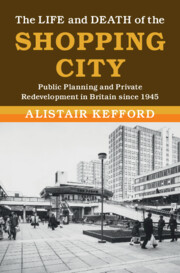 The Life and Death of the Shopping City
The Life and Death of the Shopping City Book contents
- The Life and Death of the Shopping City
- Modern British Histories
- The Life and Death of the Shopping City
- Copyright page
- Dedication
- Contents
- Figures
- Acknowledgements
- Introduction
- 1 Reconstructing Retail in the 1940s
- 2 Cities in the Age of Affluence
- 3 Making the Modern Shopping City
- 4 The Politics of Partnership
- 5 Landscapes of Leisure
- 6 Demand and Discontent in the Shopping City
- 7 Triumph of the Shopping City
- Conclusion
- List of Archives and Abbreviations
- Bibliography
- Index
5 - Landscapes of Leisure
Published online by Cambridge University Press: 31 March 2022
- The Life and Death of the Shopping City
- Modern British Histories
- The Life and Death of the Shopping City
- Copyright page
- Dedication
- Contents
- Figures
- Acknowledgements
- Introduction
- 1 Reconstructing Retail in the 1940s
- 2 Cities in the Age of Affluence
- 3 Making the Modern Shopping City
- 4 The Politics of Partnership
- 5 Landscapes of Leisure
- 6 Demand and Discontent in the Shopping City
- 7 Triumph of the Shopping City
- Conclusion
- List of Archives and Abbreviations
- Bibliography
- Index
Summary
This chapter examines the curious new landscapes of affluence which were installed in Britain’s towns and cities in the post-war decades. It shows how new shopping spaces were consciously engineered by designers as entertaining spectacles and served as sites in which a new public culture of affluence and acquisition was propagated. I relate this to the powerful political and cultural critiques of new retail environments which have proliferated in literatures on the ‘postmodern’ consumer city. I also stress that, in the 1960s, many public planners felt themselves to be engaged in the production of a new and energising type of civic space in the redeveloped shopping landscape and saw this endeavour in light of contemporary ideas about entitlements to mass leisure. For the more high-minded public planners new retail developments were a means of revitalising public space and public culture through uniting the civic with the commercial realms, and thus reflected the wider mingling of the categories of citizen and consumer, of welfare statehood with affluence. In practice this attempt to harness commercial retail development with an invigorated urban public sphere was inherently unstable and could not be sustained over the longer term.
Keywords
- Type
- Chapter
- Information
- The Life and Death of the Shopping CityPublic Planning and Private Redevelopment in Britain since 1945, pp. 200 - 243Publisher: Cambridge University PressPrint publication year: 2022
